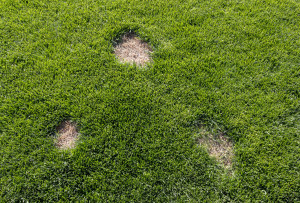Your lawn is a living, breathing organism—which means that it can become infected with fungal disease. Lawn fungi are a common problem for many homeowners, so if your lawn has been plagued with fungal disease, you are not alone. Proper lawn maintenance practices, such as watering and applying fertilizer, are the best strategies for preventing disease from taking hold in your lawn. Any stress to the lawn from the environment or human causes can make your lawn more vulnerable to diseases of any kind.

Fungi that infect lawns are spread through three different methods, according to Sod University:
- A host with living or dead organic matter, such as thatch and leaves
- Environmental conditions like shady, moist areas where the fungus can grow
- Bacteria, viruses, or other microorganisms that can serve as disease vectors
Typically, homeowners do not even realize their lawn has been infected with a fungal disease until circular or irregular patterns begin showing up in the grass. You may already be familiar with fungi like yeasts, molds, and mushrooms. There are also many harmless fungi that may call your lawn home. Some fungi may even be beneficial by decomposing grass clippings and old roots.
Five diseases tend to be likely causes of damage: brown patch, large patch, pythium blight, pink snow mold, and summer patch. You can learn about these and other diseases in this article from Sod University.
According to the University of Florida Extension, pathogens that interfere with the normal development and form of a plant can lead to disease. Diseases in grasses are usually only visible for a few months of the year due to climate conditions and their impact on the environment, yet diseases can still have an effect on the turf all throughout. It is vital to keep in mind that fungal diseases may go dormant or enter into a non-harmful stage where they live off dead organic material within the thatch and dirt. In these states, the fungal pathogen will not cause any symptoms, though it is still there and could reactivate at any moment.
Treating fungal lawn diseases with fungicide is one solution to bring your lawn back to life. Homeowners can turn to two different types of fungicides that are sold in most lawn and garden or hardware stores. One is contact fungicides, which immediately kill the fungus infection upon contact and keep working for a week to 10 days. If a homeowner is not sure about the type of fungus infecting their lawn, then a contact fungicide is usually a good choice. The other is systemic fungicides. These absorb into your grass and can even keep the fungus at bay after the infection has subsided.
There are two approaches to take when applying fungicides, preventive or curative rates, with preventive being the better option of the two, according to Sod University. They caution that curative rates may be four to five times higher. Read the fungicide instructions carefully to find out how much should be applied so you do not inadvertently cause more damage to your lawn. For homeowners applying fungicide at a curative rate, you will end up shelling out more at the register for the fungicide, so be sure to know what type of fungal infection your lawn has before pursuing this approach.
Unfortunately, there may be times when you will have to use more than one fungicide to rid your lawn of a fungal disease. Talk to a lawn care professional before combining fungicides.
Depending on the type of fungicide you want to apply, you may need to invest in some additional lawn care equipment, if you do not already have what you need for proper application. For example, granular fungicides can easily be applied using a walk-behind broadcast spreader. Liquid fungicides can be applied using a one to two-gallon garden sprayer. Homeowners can also hire a lawn care service to apply fungicide as part of a regular lawn care maintenance package.
If a fungal disease has ruined your lawn, contact Bayside Sod to help with sod repair or installing new.





